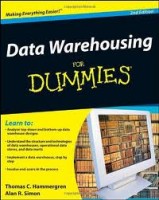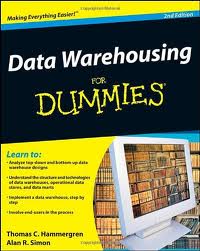 Authors: Thomas C. Hammergren and Alan R. Simon
Authors: Thomas C. Hammergren and Alan R. Simon
Publisher: For Dummies – an Imprint of Wiley Publishing
Book Review by: Venkat Subramaniam
One of the best ways to understand a concept is to simply look at it, if a picture is available. When you think about data warehousing what may come to you mind is a disk that is inside a computer. Or an external drive connected to a computer.
You will be pleased to know that an illustration is provided for you on page 12 of this book that shows you a representation of a simple data warehousing system used in a typical business.
It shows you three steps on how data is created in three aspects of a typical business. The three aspects are: place an order received from a customer, schedule a shipment to that customer, and receive a payment from that customer.
The three steps for each aspect of the business are: receive an order, process that order, and create data from that customer order. The same three steps happen for the other two aspects of the business: process the customer’s shipment and process that customer’s payment; then create data from the customer’s shipment, and create data from that customer’s payment.
All pieces of this information are stored on a device called a data warehouse. Within this device the information that is on has been received from each data field of a customer’s order, that customer’s invoice, and that customer’s payment. In the data warehouse is a customer master data file. For large businesses, the data-storage equipment is larger. And the software systems used in operating that hardware – and the integration between them – are more sophisticated.
Obviously in the data warehouse are also other pieces of information that you can retrieve to understand your business better and operate it for a higher return on your investment of money, effort and time. For example product information: what is your best-selling product? How many units of it did you sell last month and all of last year?
Or, if you have customers in different states of the country, which state gave you the largest amount of business? Other questions you have relating to most volume from a given city and zip codes within that city can also be answered. And you can choose which items of information are of use to you and which are not. You can include or exclude them when having the right person set up a data warehouse system for your business. This book will help you make choices.
So a data warehouse is not just a useful part of any business. I believe it is an essential element that any business must have, because without data about your business, you can and will lose sales opportunities; your chances to increase revenue and profits are limited.
The authors provide the essential characteristics of a good data warehouse:
- It provides centralization of corporate data assets
- It’s contained in a well-managed environment
- It has consistent and repeatable processes defined for loading data from corporate applications
- It’s built on an open and scalable architecture that can handle future expansion of data
- It provides tools that allow its users to effectively process the data into information without a high degree of technical support
This book contains very detailed information on data warehousing and it is a must for any business owner or the person in a company charged with managing its information, which is essential these days.
It has seven parts and 34 chapter titles itemized in a Contents at a Glance. If you need to look up specific information on any aspect of data warehousing, you can go to its 11-page long Table of Contents.
To give you a brief overview of its contents, here is what is covered in it:
- The Data Warehouse: Home for Your Data Assets
- Data Warehousing technology
- Business Intelligence and Data Warehousing
- Data Warehousing Projects: How to Do Them Right
- Data Warehousing: The Big Picture
- Data Warehousing in the Not-Too Distant Future
- The Part of Tens
This is an essential book to have written by two people who have extensive knowledge and intensive experience in it. For anyone who has very little familiarity with data warehousing, it can be daunting to understand how it works. And if that is the case, there are bound to be pitfalls.
The authors write that it is for this very purpose – to have people avoid pitfalls – that they wrote this book. As a matter of fact, they warn readers that there many mistakes one can make, from simply thinking about data warehousing (in the wrong way, e.g. in terms of its primary purposes) to implementing it. They point out that there are data warehousing programs that do not work as well as they are advertised, and problems do arise that you did not even anticipate.
That is why this is a must-have book, and also a must-keep one, as an invaluable reference.
Thomas C. Hammergren has been involved with business intelligence and data warehousing since he 1980s. He has helped such companies as AT&T, Duke Energy, Equifax, First Energy, Nike and Procter & Gamble build business intelligence competencies, management strategies, and solutions.
Alan R. Simon is a data warehousing expert and author of many books on data warehousing.







